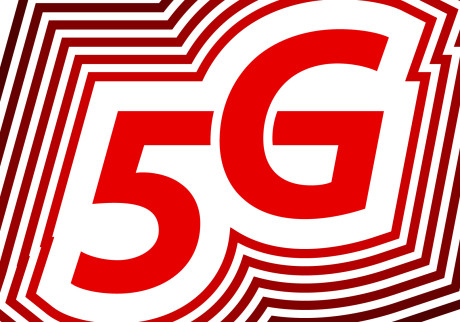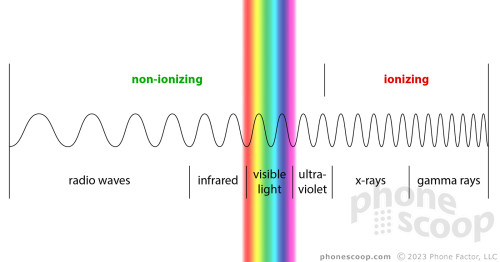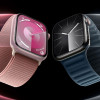Is 5G Safe?
Oct 16, 2019, 11:00 AM by Rich Brome @rbrome.bsky.social

5G is a new radio technology, so naturally those most concerned about environmental health have been asking if it's safe. New antennas are going up outside apartment windows, and most of us tend to keep our phones quite close to us at all times. There's a lot of science on the subject, and also a lot of pseudo-science. We try to cut through the bull to explain the safety issues with radio waves in general, cell phones in particular, and what makes 5G different.
We're going to start by explaining the terminology used for this topic, because there are some common misconceptions about what these terms mean. Then we're going to cover radio waves in general, because there are important, relevant principles that apply to all radio waves, including all cell phones, and all 5G technology. Finally, we'll get into what makes "5G" unique.
Also, if you're concerned about this topic because you came across an alarming article or TV segment about the dangers of 5G, make sure that wasn't actually Russian propaganda designed to hold back the US technologically and economically. Because yes, the Russians are doing exactly that.
Terminology
When looking into whether phones might pose any kind of health risk to humans, it doesn't take long to run into scary-sounding terms like "radiation", "absorption", and "safe power levels". You also quickly run into summaries of research that seem to leave a lot of wiggle room, or include alarming statements like "possibly carcinogenic to humans". In order to approach this topic rationally, it's vital to take a step back and understand what these terms mean in context. These statements are written by scientists, who strive to use language that is scientifically accurate. But what those same terms mean to you and I is often quite different.
For example, the term "radiation" comes up a lot. If you're like me, your mind might jump to something like Chernobyl when you hear this term. But the dictionary definition for the word "radiation" is "emitting energy in the form of waves or particles". So it's very broad and includes a great many things, most of which have nothing to do with radioactive particles. Phones "radiate" radio waves the same way a speaker radiates sound, or a fireplace radiates warmth. That's all "radiation" means to a scientist.
You'll also see the term "absorption", in reference to human flesh absorbing radio waves. This might also sound scary. Your body can absorb many frequencies of radio waves, which means the atoms in your tissue are, in some incredibly-tiny-but-measurable way, interacting with those waves. (And unless you live in a deep cave or faraday cage, your body does absorb radio waves all day, every day.) Asking what effect those waves have on your body is a valid question to ask. The short version is that it's like putting your hand in front of a flashlight; your hand absorbs most radio waves the same way it absorbs most light, with the same risk to your health. (More on this later.)
Scientists and researchers tend to err on the side of caution when studying health risks. They're careful to acknowledge unknowns and risks, however small. It's a bit like ads for medical drugs. An ad on TV might tell you that taking a drug could lead to death, just because one person died during a clinical trial, even if there's no evidence the drug was related to that death. But your doctor knows more about those trials and can tell you that the drug is extremely safe. Similarly, you'll probably never see a reputable study that unequivocally declares "cell phones are safe". As much as the average person would like to hear that, that's simply not how serious scientific research works. The best we can hope for is ample research showing that if any health risk exists, that risk is very small. (And that is exactly where we are. More on this later.)
But as long as there are risk levels and uncertainty, however insignificant, there will be scary phrasing like the "possibly carcinogenic to humans" classification of radio waves by the International Agency for Research on Cancer. Eeek! Out of context, that does sound scary, right? But let's put it in context. First of all, their category for "possible" is distinct from their category for "probable", and even when they say "probable", it doesn't mean a link has been proven. Other items in the "possibly carcinogenic to humans" category include coffee, the power lines inside your house, and baby powder. Finally, this "possibly carcinogenic" classification for radio waves is for all radio waves, not just cell phones. The world has been full of all kinds of radio waves for a hundred years, with no major ill effect.
The electromagnetic spectrum
As you may recall from school, radiofrequency (RF) waves exist on the electromagnetic spectrum, which also includes visible light, x-rays, and gamma rays.
There is a part of the electromagnetic spectrum that can be harmful to humans, and it's everything above visible light. That includes some ultraviolet light (which is why we use sunscreen), x-rays, and gamma rays. X-rays and gamma rays are ionizing radiation, which means they have enough energy to change the makeup of atoms (by removing an electron.) In humans, that can damage DNA, which raises the risk of cancer.
The Electromagnetic Spectrum

Radio waves are below visible light on the spectrum, along with infrared light. This is the safe — or non-ionizing — side of the spectrum, where frequencies — and thus energy levels — are too low to knock electrons out of atoms. That limits the kinds of effects radio waves can have on human tissue and DNA.
Note that "energy" in this context is not the same as power level (strength). Think of it like your teeth. An ultrasonic toothbrush (or a dentist's ultrasonic pick) uses super-fast vibrations (high frequencies) to make plaque and tartar practically fly off your teeth. That's analogous to how the high frequencies of gamma rays have enough "energy" to knock electrons out of atoms. However if you just tap your teeth quickly with your knuckle, you might be applying much more force (a higher power level), but you'd be accomplishing nothing, because of the much lower frequency (your hand muscles can't vibrate your knuckle thousands of times per second.)
Radio waves can interact with and affect matter, but generally only in the same way as their neighbors on the electromagnetic spectrum, infrared light and visible light. That is by vibrating atoms, which humans experience as heat.
So that's really all that radio waves are capable of doing to humans: heating them up. In fact, that's exactly how a microwave oven works. But the power levels are very different. (Good luck running a microwave oven on batteries!) That's part of why the FCC regulates radio power levels: to make sure no one is getting cooked. Of course, if you were getting cooked by radio waves – or even just slightly warmed up – you'd feel it.
Who should you trust?
There are many studies by industry groups on this subject, but I wouldn't blame anyone for not trusting any industry when it comes to whether its own products are safe.
How about the government? The FDA has investigated the issue in depth and determined that cell phones are safe, and set radio emission power level limits below "safe" levels just to be extra-safe. Those limits are enforced by the FCC. Those limits were created by non-political career scientists and haven't changed during various administrations, regardless of whether those in power were considered more business-friendly or consumer-friendly. The FDA, FCC, and CDC all agree that the issue has been studied, and no clear evidence of danger has been found. And yet, plenty of people simply don't trust the government, so let's see if we can find a group that's more unbiased and above reproach.
That leads us to the American Cancer Society (ACS). If you're not familiar, they are one of the oldest and most highly-respected non-profit organizations devoted to researching and fighting cancer. They were instrumental in exposing cigarettes as a carcinogen. Their staff numbers well over 5,000, they're independent, and their only agenda is fighting cancer.
Are radio waves safe?
You should read all of what the ACS has to say on the subject. It's very comprehensive. But to sum up:
The RF waves given off by cell phones don’t have enough energy to damage DNA directly or to heat body tissues. Because of this, it’s not clear how cell phones might be able to cause cancer. Most studies done in the lab have supported the idea that RF waves do not cause DNA damage.
Specifically regarding studies on humans, they have this to say:
- In most studies patients with brain tumors do not report more cell phone use overall than the controls. This finding is true when all brain tumors are considered as a group, or when specific types of tumors are considered.
- Most studies do not show a “dose-response relationship,” which would be a tendency for the risk of brain tumors to be higher with increasing cell phone use. This would be expected if cell phone use caused brain tumors.
- Most studies do not show that brain tumors occur more often on the side of the head where people hold their cell phones. This might also be expected if cell phone use caused brain tumors.
They also mention a Swedish study that did claim to find a small link on that last point, but also:
It is hard to know what to make of these findings because most studies by other researchers have not had the same results, and there is no overall increase in brain tumors in Sweden during the years that correspond to these reports.
If there was a remotely significant risk of cancer from cell phones, you would expect the ACS to be setting off alarm bells. They are not; quite the opposite, as you can see above. The majority of studies show that there is no risk, or if there is, it is incredibly small.
What about heat?
Cancer is not the only concern, though. As the FDA notes, heating (the microwave-oven effect) can be a particular concern in certain body parts:
While RF energy doesn’t ionize particles, large amounts can increase body temperatures and cause tissue damage. Two areas of the body, the eyes and the testes, are particularly vulnerable to RF heating because there is relatively little blood flow in them to carry away excess heat.
The key phrase is "large amounts". The power levels put out by phones simply aren't enough to heat up human tissue. The absolute maximum legal limit for radio energy output of a cell phone is 1/1,000th that of a microwave oven. And modern phones almost never transmit at anywhere near that level. Phones use many sophisticated technologies to make sure they're outputting the absolute minimum amount of radio energy at any given moment, simply to conserve battery life.
Also, the way most of us use our phones, your phone receives far more than it transmits. A phone that's strictly downloading data isn't outputting any radio energy at all. (Phones are almost always uploading and downloading, but it's very heavily skewed to the download side in most situations.)
To reach the maximum RF power level output from your phone, (which is still about 1/2,000th that of a microwave oven,) you'd need to do something like broadcast live-stream video from your phone in a part of your network with relatively poor coverage. Even then, the leading research says you should be fine. But if you're skeptical, maybe don't hold your phone against your eyeballs or testicles (if you have them) while you engage in that (very specific) activity.
And what is the "risk" here? Not cancer; we've established that. We're talking about your eyeball being a fraction of a degree warmer, for likely just few minutes. That's a risk I'm fine with.
What makes 5G different
There are two "flavors" of 5G: mmWave and non-mmWave. In the US, both are being deployed. It's important to make the distinction. mmWave stands for millimeter wave, and refers the frequency. It's only the mmWave type of 5G that requires new kinds of antennas in new places, because the frequencies are much higher. If you're seeing those antennas being installed on light poles in your neighborhood, those are mmWave antennas.
Some companies are deploying 5G in existing frequency bands also used for 4G – not mmWave – and using essentially the same kinds of antennas you're used to seeing for decades on towers and rooftops. Sprint is doing this exclusively for its 5G network so far; they're not using mmWave at all. This flavor of 5G (sometimes call sub-6 GHz) is no different from 4G when it comes to the way it affects the human body.
(In fact, the 5G standard is heavily based on the 4G standard. One dirty secret of the industry is that the 5G standard is barely a new standard at all, but more like an evolution of the 4G standard.)
So when people say 5G is a new thing that requires further study on its health effects, they're technically talking about mmWave frequency bands, not the 5G standard itself.
As for mmWave, it's still just radio waves, and all radio waves are non-ionizing, which is the "safe" end of the electromagnetic spectrum, as explained above.
But if anything, mmWave frequencies are far "safer" than other radio frequency bands (not to say those are dangerous.) That's because radio waves at frequencies that high don't penetrate solids well, including your body. The outer layers of your skin block the signal quite well, as do walls and even glass. That's why a mmWave 5G network needs so many antennas spread around town, so close together. It needs a dense mesh of antennas to provide decent coverage given how poorly it penetrates anything solid.
So when it comes to physics and the human body, the only new thing about 5G is that the mmWave flavor of it is too weak to even reach your insides, much less cause any health effects to them.
mmWave radio energy can only reach your skin. There, all it can theoretically do is heat it up, although it's not powerful enough to actually do so. Even if it could, your skin is the one part of your body best-equipped to shed any excess heat; in fact that's part of its function.
If you want to know more about other aspects of 5G, check out the other articles in our series on 5G: What is 5G? The Basics and 10 Reasons You Can Ignore 5G.
Comments
Wireless danger
But as the article explains, neither is dangerous.
5G Risks
I'd be curious for Rich's or others thoughts on HPUE, high power user equipment as it relates to any concerns for safety (if any).
-Dan


 iPhone 15 Series Goes All-In on USB-C and Dynamic Island
iPhone 15 Series Goes All-In on USB-C and Dynamic Island
 Samsung S24 Series Adds More AI, Updates the Hardware
Samsung S24 Series Adds More AI, Updates the Hardware
 Asus ROG Phone 7 is a Gaming Powerhouse
Asus ROG Phone 7 is a Gaming Powerhouse
 Motorola's New Flagship Gets its Signature Edge Back
Motorola's New Flagship Gets its Signature Edge Back
 Apple Watch Series 9 Detects Finger Gestures, Brings Siri On-Device
Apple Watch Series 9 Detects Finger Gestures, Brings Siri On-Device


